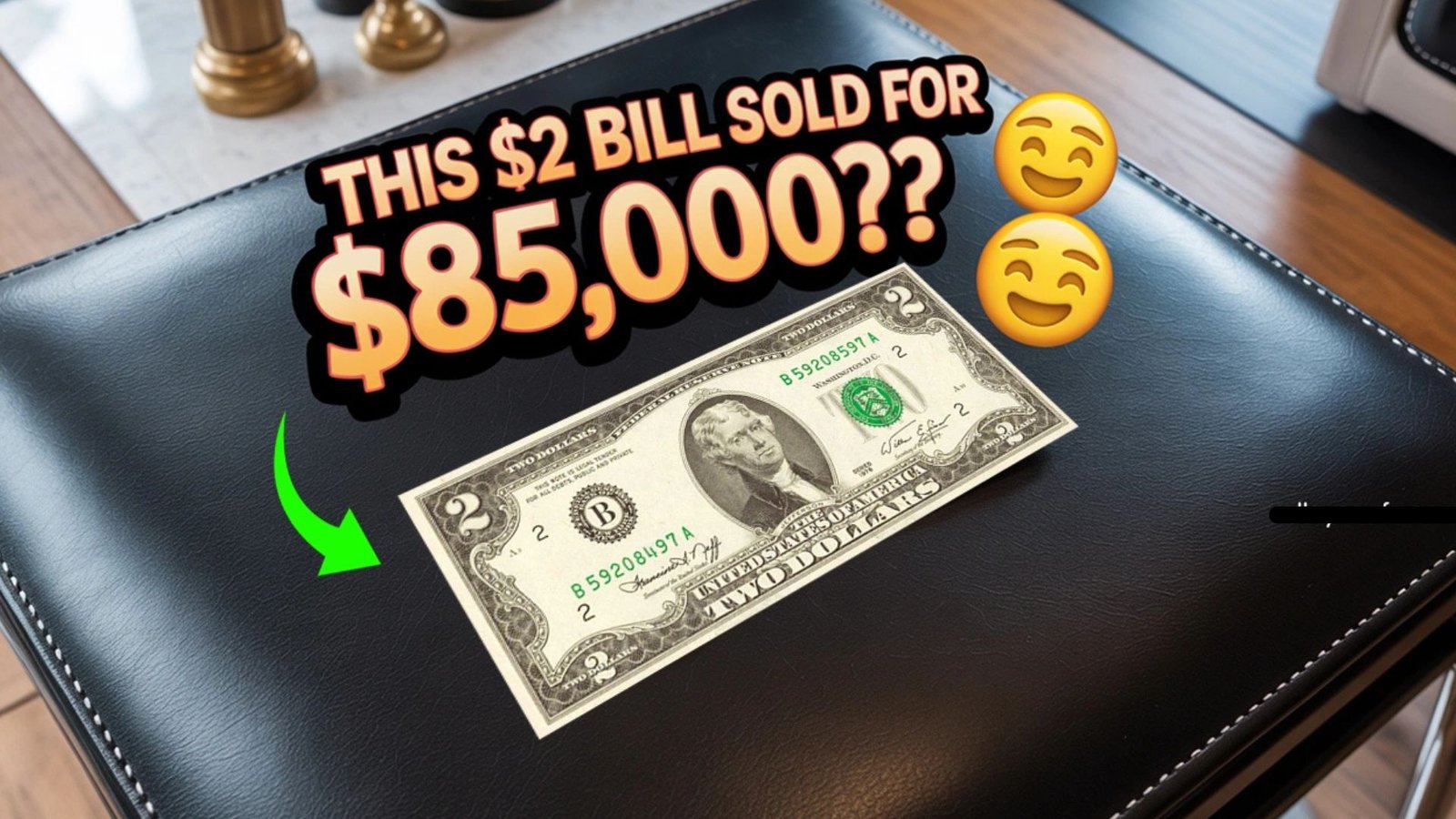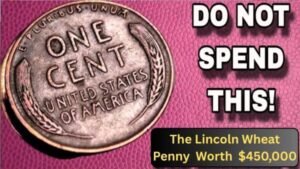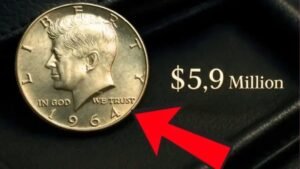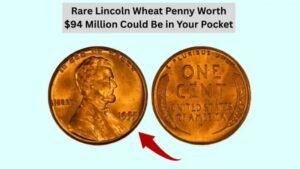Did you recently use a $2 bill to buy coffee? You might have spent a fortune! The U.S. $2 bill, featuring Thomas Jefferson, is a rare sight in circulation, and some versions with unique serial numbers or errors can be worth up to $85,000. In 2025, a rare 1976 $2 bill with a printing error sold for that amount at auction, thrilling collectors. This SEO-optimized guide explains how to spot a valuable $2 bill, why some are so special, and how to turn your spare change into a big payday. Check your wallet now—you could be holding a treasure!
What Is a $2 Bill?
The $2 bill is a U.S. currency note first issued in 1862, with Thomas Jefferson’s portrait on the front (obverse) and a painting of the Declaration of Independence signing on the back (reverse). Though still legal tender, $2 bills are rarely used, making them a curiosity. Most are worth their face value of $2, but rare versions from specific years, like 1976 or 1928, with unique serial numbers or printing errors, can fetch thousands due to their scarcity and collector demand.
Why Are Some $2 Bills So Valuable?
The value of a $2 bill depends on several factors:
- Serial Numbers: Unique patterns like solid digits (e.g., 22222222) or low numbers (e.g., 00000001).
- Series Year: Older series (1928, 1953) or the 1976 Bicentennial series are often more valuable.
- Errors: Printing mistakes, like misaligned text or mismatched serial numbers.
- Condition: Uncirculated bills (like new) graded by PMG or PCGS fetch higher prices.
A 1976 $2 bill with a rare “mismatched serial number” error, where the two serial numbers on the front don’t match, sold for $85,000 in 2025.
Rare $2 Bills to Look For
Here are the top $2 bill varieties that could make you rich:
1976 Mismatched Serial Number
This error occurs when the two serial numbers on the front of a 1976 $2 bill are different (e.g., one is 12345678 and the other is 12345679). Only a few are known, with one selling for $85,000 in uncirculated condition at a 2025 auction.
1928 Red Seal $2 Bill
Early $2 bills from 1928 with a red Treasury seal are rare, especially in uncirculated condition. They can be worth $500–$20,000, depending on the series (1928, 1928-D, or 1928-G).
Low Serial Number Star Notes
Star notes, marked with a star () in the serial number, are replacement bills for printing errors. A low serial number like 00000001 on a 1976 or 1953 bill can fetch $1,000–$10,000.
1976 Solid Serial Number
A 1976 $2 bill with a solid serial number, like 77777777, is extremely rare and can be worth $5,000–$25,000 in top condition.
How to Spot a Valuable $2 Bill
To find a rare $2 bill, check these details:
- Series Year: Look for 1928, 1953, or 1976 near Jefferson’s portrait.
- Serial Number: Check both serial numbers on the front for patterns like 77777777, low numbers (00000001), or mismatches. A star (*) indicates a replacement note.
- Errors: Look for misaligned printing, inverted designs, or missing elements.
- Condition: Uncirculated bills with no folds or wear are worth more. Use a magnifying glass to inspect details.
Compare your bill to images on PMG or PCGS to confirm its value.
Market Value of Rare $2 Bills
Most $2 bills are worth $2–$5, but rare varieties command high prices:
| Bill Type | Estimated Value | Key Feature |
|---|---|---|
| Regular $2 Bill (1976, Circulated) | $2–$5 | Common, no errors |
| 1976 Mismatched Serial Number | $10,000–$85,000 | Different serial numbers on front |
| 1928 Red Seal $2 Bill | $500–$20,000 | Red Treasury seal, older series |
| Low Serial Number Star Note | $1,000–$10,000 | Star () with low number (e.g., 00000001) |
| 1976 Solid Serial Number | $5,000–$25,000 | Same digit repeated (e.g., 77777777) |
Values depend on condition, series, and grading by PMG or PCGS.
Why Are $2 Bills Still in Circulation?
The U.S. Mint prints $2 bills sporadically, with major runs in 1928, 1953, 1976, and 2003. Their rarity in everyday use—due to public perception as “unlucky” or collectible—means many are hoarded in drawers or jars. Errors like mismatched serial numbers slipped into circulation due to printing oversights, especially during the 1976 Bicentennial release. Coin roll hunting, popularized on platforms like X, keeps collectors searching for these treasures in 2025.
How to Sell a Rare $2 Bill
If you find a potential gem:
- Check Details: Confirm the year, serial numbers, and any errors with a magnifying glass.
- Authenticate: Send it to PMG or PCGS for grading to verify authenticity and condition.
- Sell Smart: Contact auction houses like Heritage Auctions or sell on eBay after grading.
Avoid folding or cleaning the bill, as damage lowers its value. Consult a currency dealer for guidance.
Word Translation Table
| Complex Word | Simple Meaning |
|---|---|
| Obverse | Front side of a bill |
| Reverse | Back side of a bill |
| Serial Number | Unique code printed on a bill |
| Uncirculated | Bill with no wear, like new |
| Numismatist | Person who collects bills or coins |
| Star Note | Replacement bill with a star in the serial number |
FAQs
How do I know if my $2 bill is valuable?
Check the year (1928, 1953, 1976), serial numbers for patterns like 77777777 or mismatches, and for a star (*). Use a magnifying glass and compare to PMG or PCGS images.
What makes a $2 bill worth $85,000?
A mismatched serial number error on a 1976 bill, where the two serial numbers differ, is rare and valuable, especially in uncirculated condition, as seen in a $85,000 sale in 2025.
Where can I sell a rare $2 bill?
Sell through auction houses like Heritage Auctions or Stack’s Bowers, or on eBay after grading by PMG or PCGS. Local currency dealers can also appraise.
Are all $2 bills valuable?
No, most are worth $2–$5. Only those with rare serial numbers, errors, or from specific years (1928, 1976) are valuable.
Conclusion
Your $2 bill could be a collector’s treasure, with rare versions like the 1976 mismatched serial number bill worth up to $85,000. Check for unique serial numbers, errors, or older series like 1928 or 1953, especially in uncirculated condition. With $2 bills still in circulation, you might find one in a cash drawer or bank roll. Authenticate with PMG or PCGS and sell through trusted auction houses to maximize value. Don’t spend that $2 bill yet—it could be your ticket to a fortune! Visit Heritage Auctions or PMG for grading and auction details.




